Overview
The article titled "10 Applied Behavioral Analysis Examples for Effective Parenting" aims to provide parents with practical, nurturing examples of applied behavioral analysis (ABA) techniques that can significantly support their children's development. It highlights the value of these techniques, such as:
- Discrete Trial Training
- The Picture Exchange Communication System
These methods have been proven to enhance communication, social skills, and the overall quality of life for children with autism. By understanding and implementing these strategies, parents are empowered to foster positive behavioral changes within their homes, creating a supportive environment for their children.
Introduction
In a world where understanding and supporting children with autism is more crucial than ever, applied behavioral analysis (ABA) shines as a beacon of hope for parents seeking effective strategies. This article explores ten practical examples of ABA techniques designed to empower caregivers in fostering essential skills in their children—ranging from communication to daily living. Yet, with a myriad of approaches available, how can parents discern which methods will truly yield the best results for their unique situations? By delving into these ABA examples, families may uncover the potential for meaningful growth and connection while navigating the challenges of autism together.
About ASD Media: Empowering Parents with ABA Therapy Resources
At ASD Media, we understand the challenges that caregivers face when navigating the complexities of applied behavioral analysis examples within ABA therapy. We are dedicated to providing valuable insights and strategies that empower both caregivers and professionals to overcome obstacles and achieve meaningful results. Our diverse array of resources—including expert articles, webinars, and community forums—supports families on their journey with autism and ADHD. By subscribing to our newsletter, you’ll gain access to the latest news and unlimited digital resources, ensuring you stay informed about the evolving landscape of ABA therapy.
Our mission is to cultivate a supportive and inclusive community where caregivers can share their experiences, learn from one another, and receive guidance tailored to their unique situations. In this cooperative atmosphere, parents and experts come together to unlock the potential of youth with autism and ADHD. We emphasize the importance of effective approaches, including applied behavioral analysis examples, for addressing challenging behaviors, accessing support services, and fostering interpersonal development.
Current trends in ABA therapy include applied behavioral analysis examples that highlight the growing recognition of its efficacy, with research showing an impressive success rate of over 89% in enhancing communication, social skills, and overall development in children with autism. However, the financial implications of autism therapy are significant, with costs averaging around $60,000 per year. This reality underscores the need for accessible resources, which is why ASD Media is committed to providing parents with the tools they need to implement successful applied behavioral analysis examples at home. By prioritizing community support and continuous learning, we play a crucial role in enhancing the lives of families affected by autism and ADHD.
We invite you to join our community, share your experiences, and explore the wealth of resources available to you. Together, we can make a difference in the lives of those we care for.
Discrete Trial Training: Structured Learning for Skill Acquisition
Discrete Trial Training (DTT) is a nurturing and structured teaching approach used in ABA therapy. It breaks down skills into small, manageable components, making learning feel achievable for your child. Each skill is taught through a series of trials where your little one is encouraged to respond, followed by positive reinforcement for correct answers. This method is particularly effective for teaching new skills, as it allows for repeated practice and immediate feedback, helping your child gain a clear understanding of the desired behavior.
As a parent, you can easily implement DTT at home. By using simple prompts and rewards, you can create a supportive learning environment that encourages your child's growth. Remember, every small step counts in this journey, and your involvement makes a significant difference. Have you tried using DTT techniques at home? Share your experiences in the comments below; your insights could inspire other parents on a similar path.

Picture Exchange Communication System: Enhancing Communication Skills
The Picture Exchange Communication System (PECS) is a powerful tool designed to empower youth with limited verbal skills, enabling them to communicate through pictures. This method encourages young individuals to exchange images that represent their desired items or actions with a communication partner, fostering a sense of independence in their interactions. PECS is especially beneficial for nonverbal individuals, as it alleviates frustration and significantly enhances their ability to express needs and wants. Research shows that around 25-30% of autistic individuals are minimally verbal or do not develop functional language, highlighting the essential role of PECS in their communication journey.
To introduce PECS, caregivers can begin by presenting a few picture cards of favorite items, gradually expanding the vocabulary as the individual becomes more comfortable with the system. Speech therapists emphasize that utilizing PECS not only aids in communication but also boosts confidence in nonverbal individuals, allowing them to articulate their thoughts and emotions more effectively. For instance, one parent shared how their child, who once struggled to indicate hunger, now confidently uses PECS to request snacks, transforming their daily interactions.
Success stories abound, showcasing children who have moved from frustration to empowerment through the use of PECS, illustrating its profound impact on their daily lives and overall quality of life. By embracing this approach, parents can create new opportunities for dialogue, fostering a more inclusive environment for their children. Collaboration between families and therapists is crucial in setting goals and tracking progress, ensuring that the implementation of PECS is customized to meet each individual's unique needs.
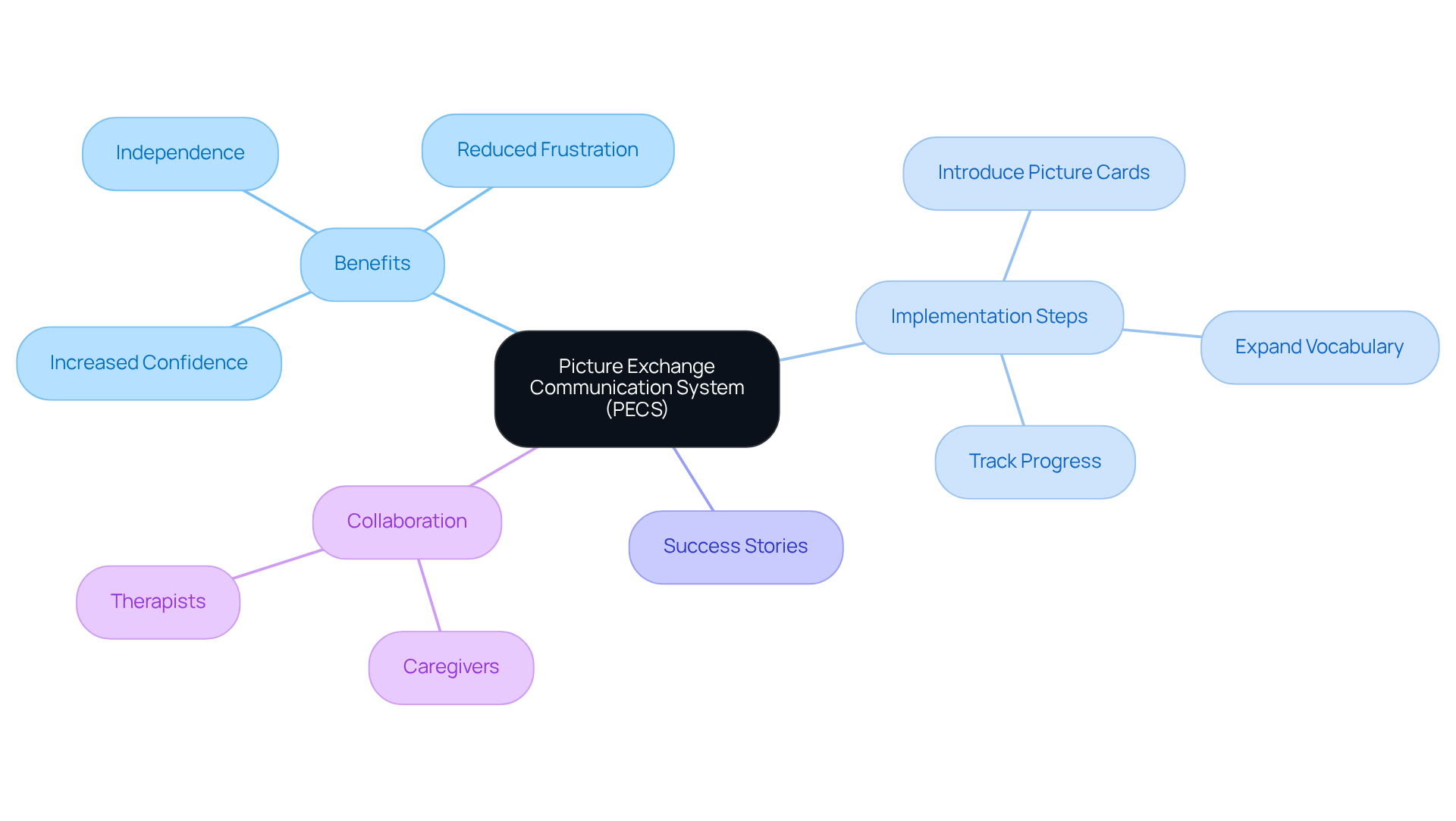
Reinforcement Systems: Encouraging Positive Behavior Through Rewards
Reinforcement systems are vital in Applied Behavior Analysis (ABA) therapy, as they reward desired behaviors, encouraging their frequency. Imagine the joy of seeing your child engage in positive actions—this is where positive reinforcement comes into play. It can take many forms, such as verbal praise, tokens, or tangible rewards. Research indicates that effective reinforcement techniques can lead to remarkable improvements in behavior, with over 90% of children showing significant progress in their social and communication skills through ABA interventions.
For parents, establishing a reinforcement system at home is crucial for nurturing good behavior and motivating children to pursue positive actions. Tailoring the reinforcement to align with your child's preferences can enhance its effectiveness. For instance, some children may respond more favorably to verbal commendation, while others might be more inspired by physical rewards like stickers or extra playtime.
Behavior analysts highlight the importance of consistency in applying reinforcement strategies. By consistently recognizing and rewarding positive behaviors, you not only strengthen those actions but also foster a nurturing environment where children can thrive. Consider practical applied behavioral analysis examples of positive reinforcement methods, such as:
- Creating a reward chart for completing chores
- Implementing a token economy system, where children earn tokens for good behavior that can be exchanged for a favorite activity
In conclusion, effective reinforcement systems are essential in ABA therapy. They not only encourage positive behavior but also empower children to develop essential skills and confidence. As you explore these strategies, remember that your involvement and understanding can make a world of difference in your child's journey.
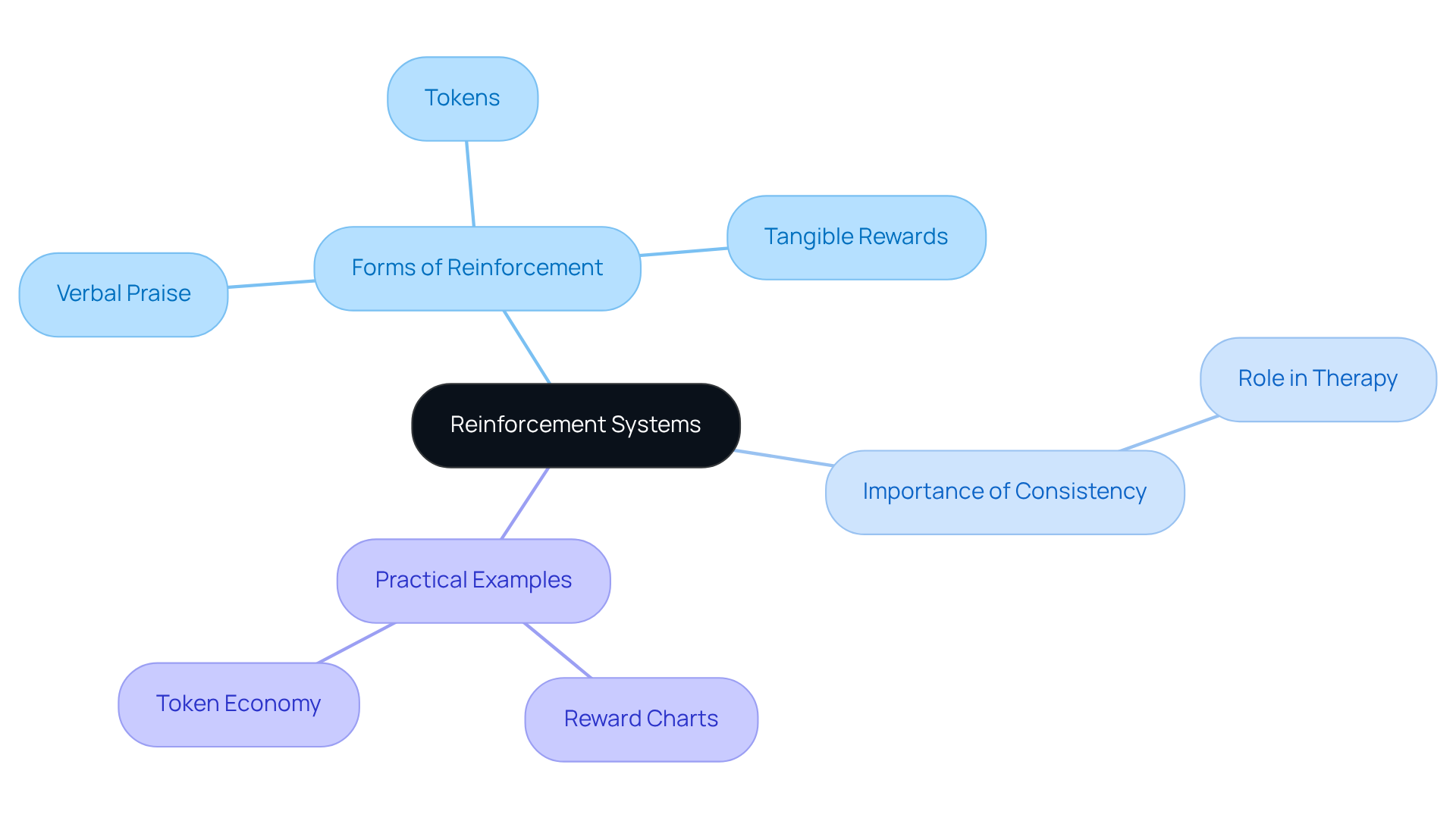
Modeling: Teaching Skills Through Demonstration
Modeling serves as a powerful teaching strategy, allowing young learners to acquire knowledge by observing and imitating others. In the context of ABA therapy, therapists often demonstrate applied behavioral analysis examples of desired behaviors—such as social greetings or self-care tasks—enabling children to replicate these actions. For example, a therapist might use applied behavioral analysis examples to show how to share toys during playtime, providing a clear model for the child to follow. Parents, too, can effectively employ modeling in everyday situations by demonstrating tasks like following a daily routine or expressing emotions appropriately. This nurturing method not only imparts essential skills but also reinforces positive behaviors through observation, creating a supportive learning environment.
Recent studies underscore the significance of observational learning, particularly for individuals with autism, indicating that modeling can significantly enhance skill acquisition and social interactions. Experts in the field emphasize that effective modeling can lead to improved communication and adaptive behaviors, making it a vital component of development. By integrating modeling into daily life, parents can create valuable opportunities for their children to learn and thrive, ultimately unlocking their full potential.
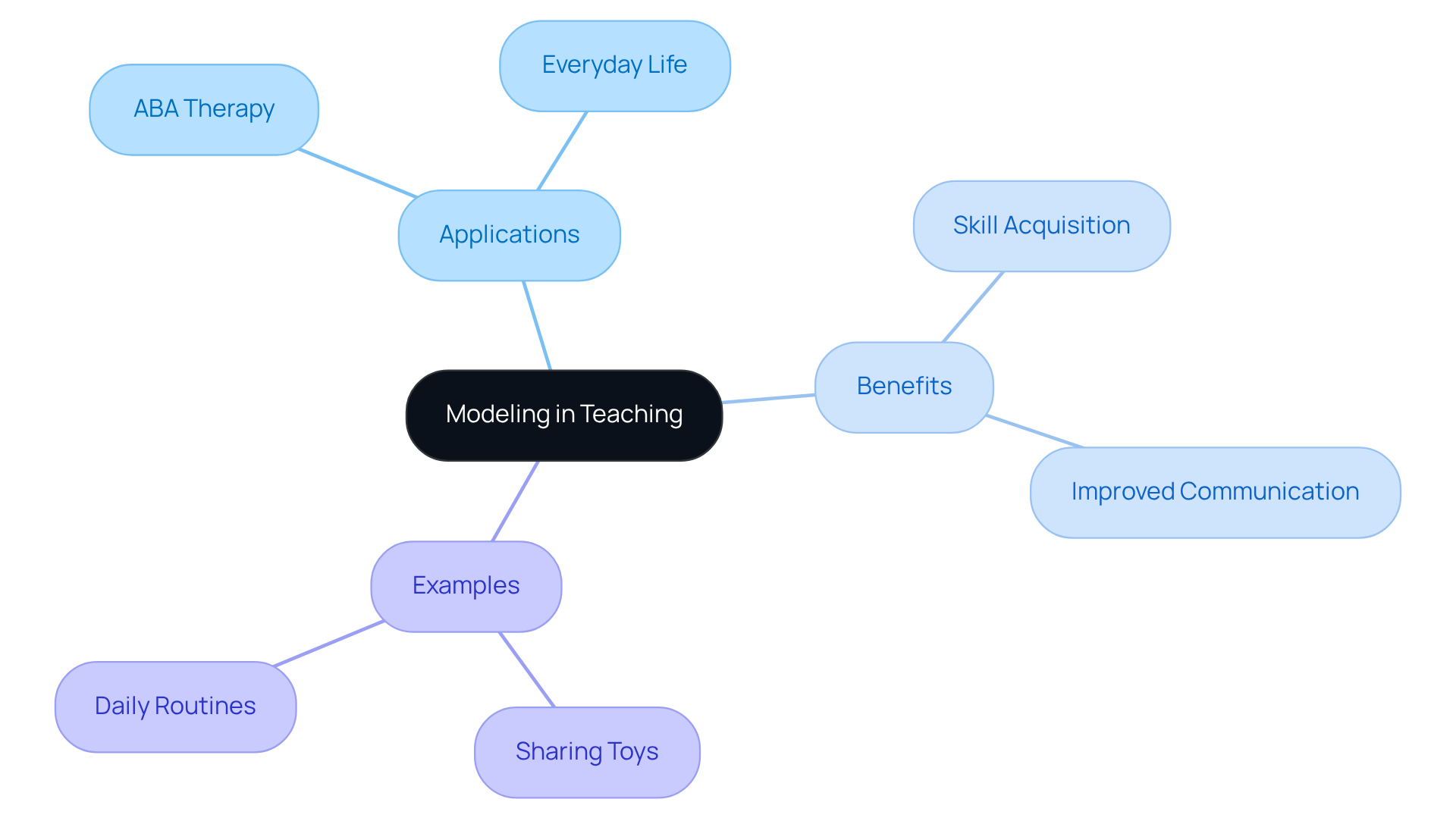
Early Start Denver Model: Effective Early Intervention Strategies
The Early Start Denver Model (ESDM) is a compassionate, evidence-based intervention tailored for children with autism aged 12 to 48 months. This nurturing model beautifully integrates ABA principles with developmental methods, placing a strong emphasis on enhancing communication abilities through engaging, play-based activities. It's essential to recognize the importance of early intervention; research shows that starting treatment early can lead to remarkable improvements in cognitive and language skills.
As a parent, you can incorporate ESDM strategies into your daily life by engaging in interactive play and nurturing communication during everyday routines. Imagine the joy of watching your child thrive as you share moments of connection and discovery. By embracing these techniques, you not only support their development but also foster a loving environment where they feel understood and valued.
We invite you to explore these strategies further and consider how they might fit into your family's journey. Every small step you take can pave the way for significant progress, and you're not alone in this. Together, we can create a supportive community where experiences and insights are shared, helping each other navigate the challenges and triumphs of parenting a child with autism.
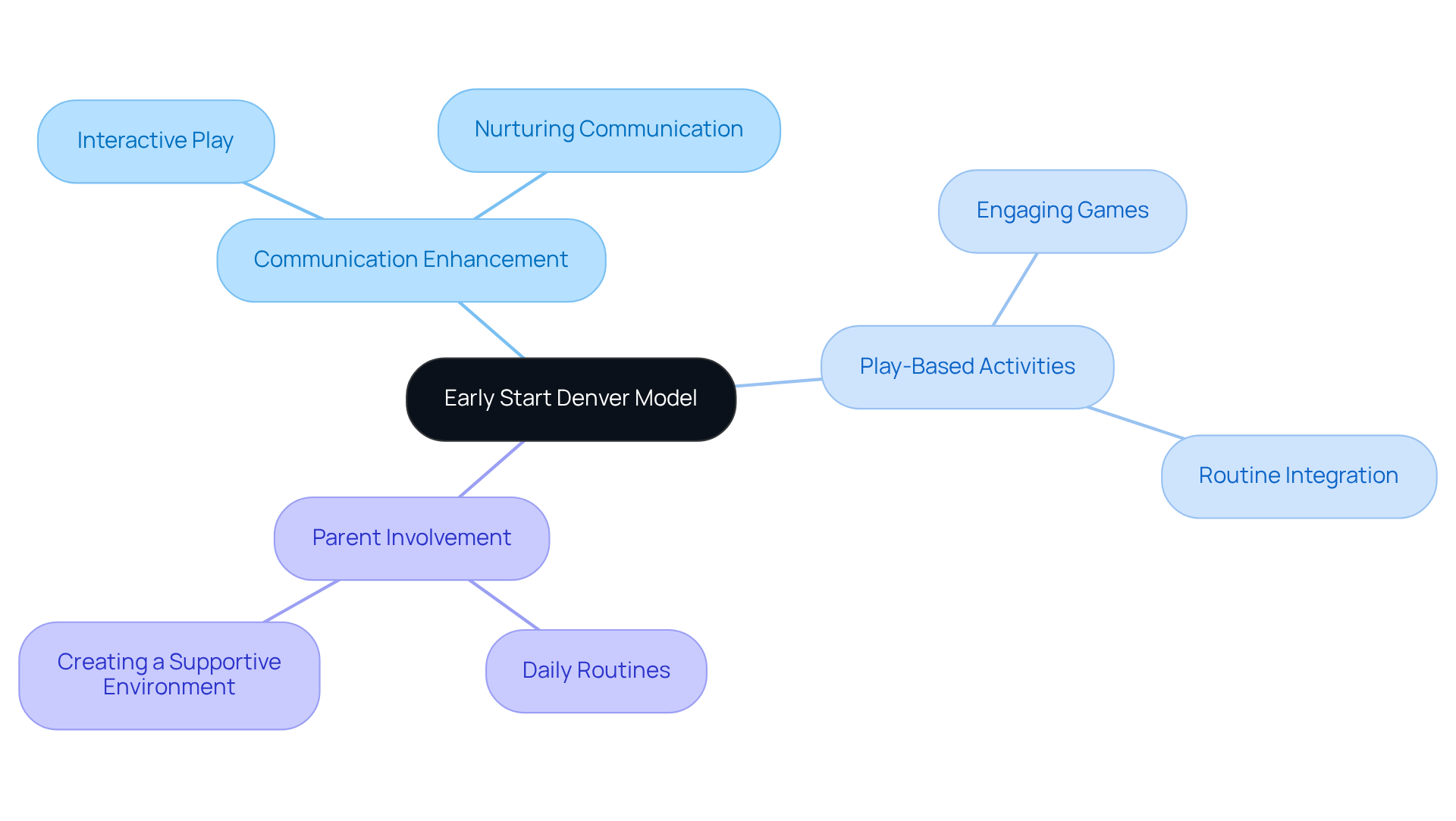
Pivotal Response Treatment: Targeting Key Developmental Areas
Pivotal Response Treatment (PRT) is a naturalistic ABA intervention designed to enhance vital areas of a young person’s development, such as motivation, self-initiation, and social interaction. By focusing on these essential elements, PRT promotes significant improvements across a range of skills. This approach, which encourages youth-initiated participation, allows young individuals to engage in activities that truly interest them, leading to a remarkable boost in their motivation and learning outcomes.
Parents play a crucial role in supporting PRT. By offering choices and creating opportunities for their children to initiate interactions and activities, they can foster a more engaging learning environment. Research indicates that children undergoing PRT show improved transfer of skills in real-world settings, suggesting that this method effectively encourages lasting advancements in communication.
Moreover, practitioners emphasize the importance of learner-initiated education. When young individuals are empowered to choose their activities, they tend to exhibit fewer instances of off-task and disruptive behavior. This results in more productive and fulfilling learning experiences. As you explore PRT for your child, consider how you can support their journey by providing the right opportunities and encouragement.
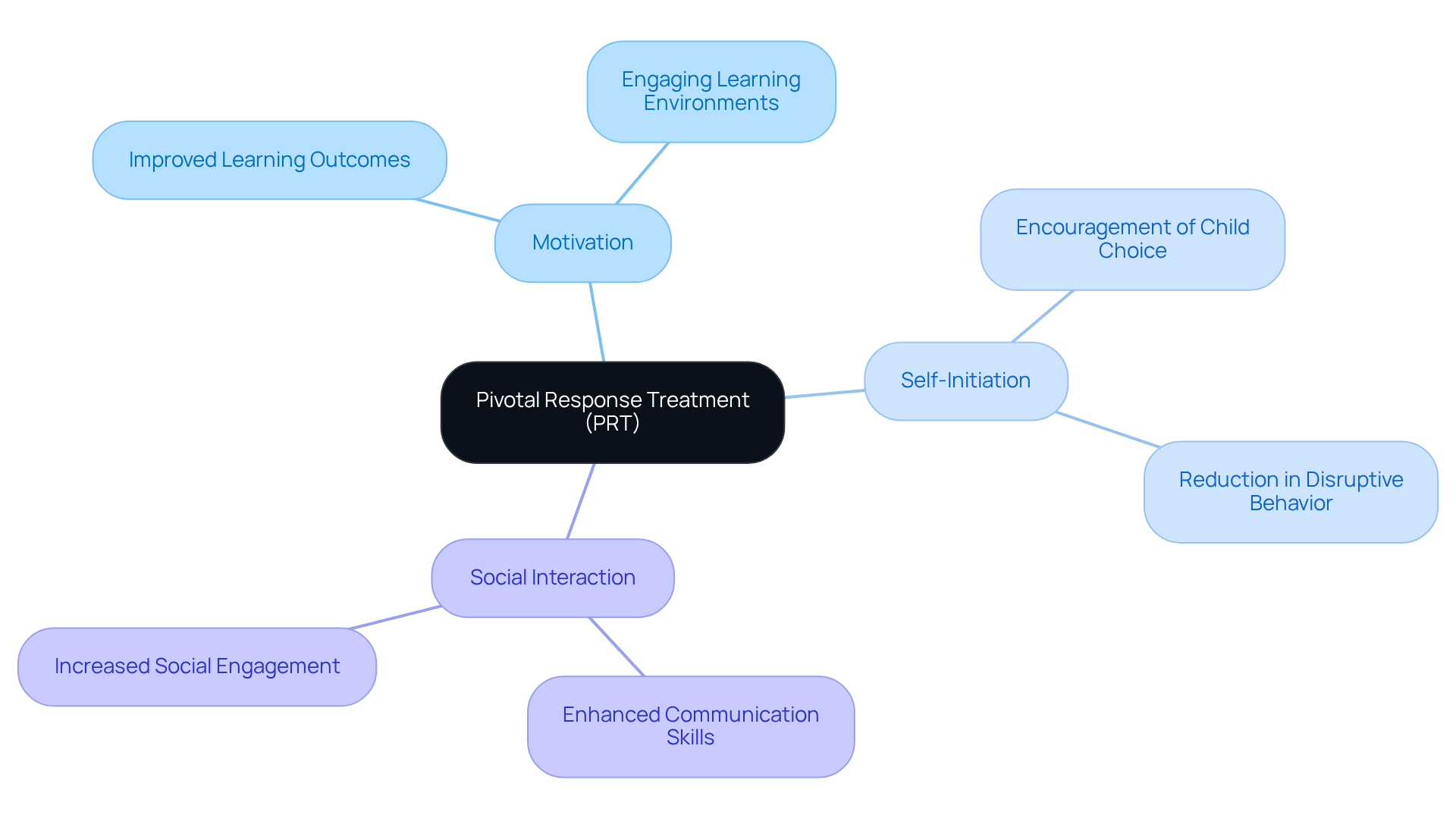
Social Skills Training: Fostering Peer Interaction and Communication
Social abilities training is not just a method; it’s a lifeline for children with autism, teaching them how to engage meaningfully with their peers. This approach typically incorporates:
- Role-playing
- Narrative scenarios
- Organized group activities
These elements foster a nurturing environment where practice can thrive. Parents are vital in this journey, facilitating playdates, encouraging participation in group activities, and modeling appropriate interactions. For instance, structured playdates allow children to hone their interpersonal skills in a safe space, enhancing their ability to form friendships while reducing anxiety and improving overall relational competence.
As we explore current trends in peer interaction strategies, the integration of technology, such as video modeling, emerges as a beacon of hope, showing positive response rates around 84%. Psychologists advocate for these approaches, emphasizing that nurturing social abilities not only enriches peer interactions but also significantly contributes to the emotional well-being and self-esteem of children with autism. With growing awareness of these strategies, parents are increasingly empowered to create enriching opportunities for their children to flourish socially. Together, let’s foster an environment where every child can thrive.
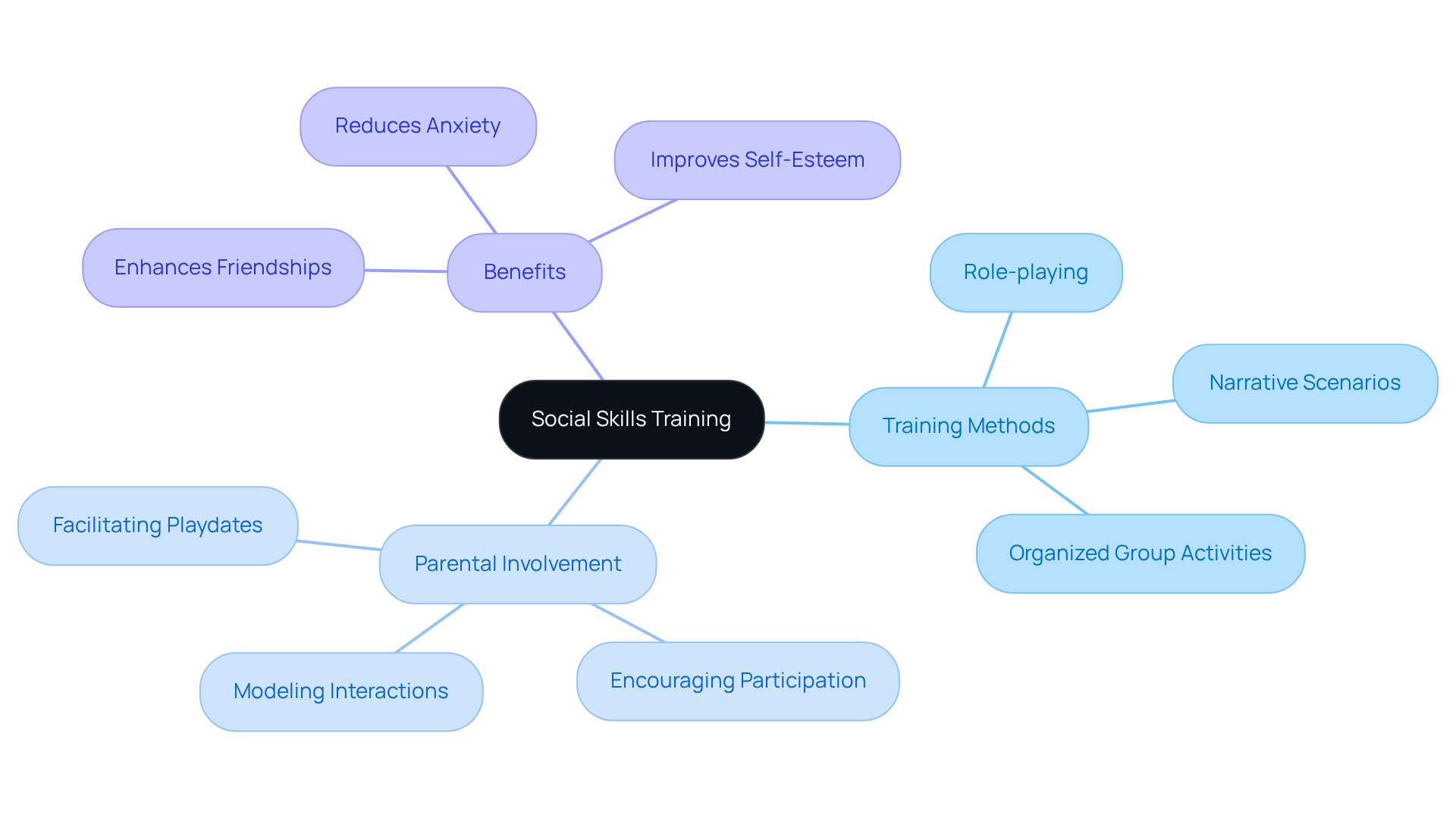
Academic Skills Training: Supporting Educational Achievement
Educational training within Applied Behavior Analysis (ABA) is essential for enhancing students' learning abilities in reading, writing, and math. This compassionate approach emphasizes personalized teaching tailored to each student's unique needs, utilizing visual aids and reinforcement techniques to boost engagement and understanding.
Research shows that structured study environments significantly improve learning outcomes, while visual aids help clarify complex concepts. For example, there are 16 different task boxes available to teach specific social skills, which can be vital in supporting academic success.
Parents play an invaluable role in this journey by:
- Actively participating in their children's education
- Creating organized study spaces
- Using positive reinforcement to celebrate their progress
As Dr. Temple Grandin wisely states, 'Different, not less,' highlighting the importance of recognizing each individual's distinct learning style. By nurturing a supportive learning atmosphere, parents can foster a positive attitude toward education, ultimately enhancing their children's academic achievement.
Daily Living Skills Training: Promoting Independence and Self-Sufficiency
Training in daily living abilities is essential for equipping young individuals with the skills they need for independence. This training encompasses vital areas such as personal hygiene, meal preparation, and household tasks. Research indicates that effective training in these areas can significantly enhance the quality of life for individuals with autism. Notably, studies have shown a remarkable improvement in daily living capabilities following intervention (p < .001), as published in July 2016 in Research in Developmental Disabilities.
Parents play a pivotal role in this journey. By breaking tasks into manageable steps, utilizing visual schedules, and creating opportunities for practice in real-life contexts, they can make a profound difference. For instance, involving children in culinary activities not only teaches valuable skills but also fosters confidence and independence.
Current trends highlight the integration of technology, such as the ShowMeHow app, which has demonstrated promising effectiveness in enhancing learning experiences. Augmented reality applications also add to these innovative approaches. By actively promoting these skills, parents can empower their children to achieve greater independence in their daily routines. This, in turn, leads to improved self-sufficiency and a better quality of life for the whole family.
How have you supported your child's journey towards independence? Sharing your experiences could inspire others in our community.
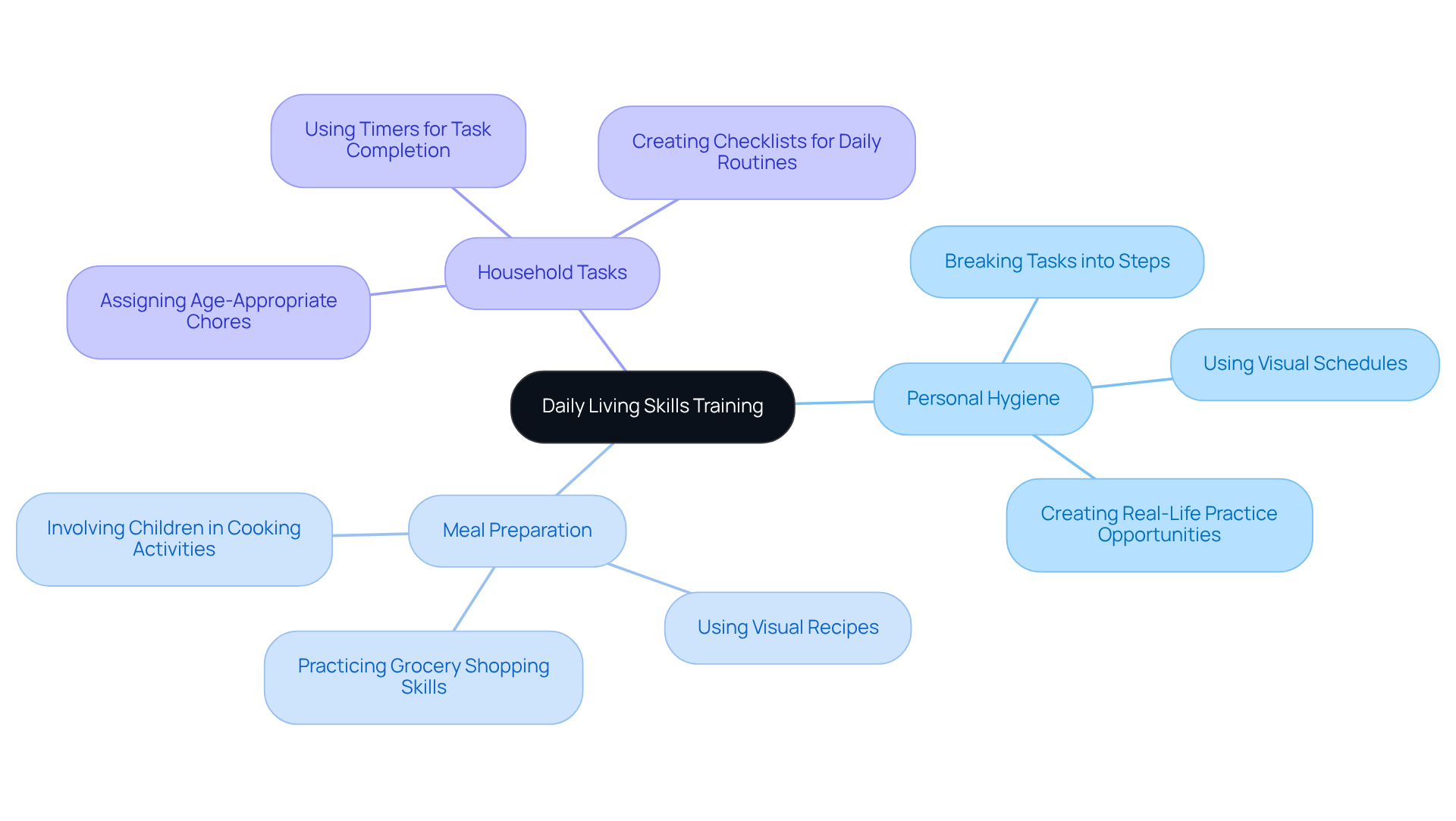
Conclusion
In conclusion, this article beautifully illustrates the transformative power of applied behavioral analysis (ABA) techniques in empowering parents to support their children with autism. By delving into ten practical examples, it demonstrates how these strategies can nurture essential skills, enhance communication, and promote independence, ultimately enriching the quality of life for both children and their families.
Key insights reveal the effectiveness of methods such as:
- Discrete Trial Training
- the Picture Exchange Communication System
- Pivotal Response Treatment
in addressing diverse developmental needs. Each approach not only facilitates skill acquisition but also reinforces positive behaviors, encouraging children to thrive in their daily interactions. Moreover, the significance of parental involvement and the integration of technology in these interventions are highlighted as crucial elements for successful implementation.
Navigating the journey of parenting a child with autism can be both challenging and rewarding. It is vital for caregivers to remain informed and engaged. By utilizing resources available through platforms like ASD Media, parents can connect with a supportive community, share experiences, and access valuable tools that promote effective parenting strategies. Together, let’s continue to cultivate an inclusive environment where every child can flourish and reach their full potential.
Frequently Asked Questions
What is ASD Media and its mission?
ASD Media is dedicated to empowering parents and caregivers with resources related to ABA therapy, providing insights and strategies to help them navigate challenges associated with autism and ADHD. Their mission is to cultivate a supportive community where caregivers can share experiences and receive tailored guidance.
What types of resources does ASD Media offer?
ASD Media offers a diverse array of resources including expert articles, webinars, community forums, and a newsletter that provides the latest news and unlimited digital resources on ABA therapy.
What is Discrete Trial Training (DTT)?
Discrete Trial Training (DTT) is a structured teaching approach used in ABA therapy that breaks down skills into small, manageable components. It involves a series of trials where children are encouraged to respond, followed by positive reinforcement for correct answers.
How can parents implement DTT at home?
Parents can implement DTT at home by using simple prompts and rewards to create a supportive learning environment that encourages their child's growth. Consistent practice and immediate feedback are key components.
What is the Picture Exchange Communication System (PECS)?
The Picture Exchange Communication System (PECS) is a tool designed to help individuals with limited verbal skills communicate through pictures. It allows them to exchange images that represent their desired items or actions, fostering independence in communication.
Who benefits from using PECS?
PECS is especially beneficial for nonverbal individuals or those who are minimally verbal, as it enhances their ability to express needs and wants, alleviating frustration and boosting confidence.
How can caregivers introduce PECS to their children?
Caregivers can start by presenting a few picture cards of favorite items and gradually expanding the vocabulary as the individual becomes more comfortable with the system.
What is the success rate of ABA therapy?
Research shows that ABA therapy has an impressive success rate of over 89% in enhancing communication, social skills, and overall development in children with autism.
What are the financial implications of autism therapy?
The average cost of autism therapy is around $60,000 per year, highlighting the need for accessible resources for families.
How can parents engage with the ASD Media community?
Parents are invited to join the ASD Media community to share their experiences and explore the wealth of resources available, contributing to a collaborative environment aimed at enhancing the lives of families affected by autism and ADHD.




